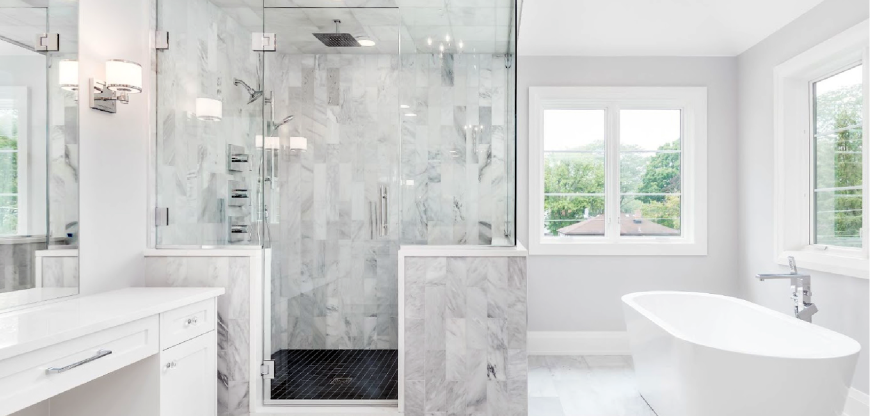Blog
I Can See Clearly Now The Rain Has Gone!

Two weeks ago, we began discussing shower design, whether to go more rectangular or to be a square, man. Now, we’ll talk about bedazzling the shower. Like are you the type to wear a tux to the Met Gala or an ugly sweater for star billing on the Jumbotron?
Let’s start with a question we’re asked monthly: “How can we minimize grout lines?” I understand that pain, because I’m convinced a previous owner of our house found their 2” x 2” tan tile on clearance, then used 3/8” spacers. No bueno. Yet solutions are here, because there are ways to have solid walls with just silicone in the corners, though for some of them you might need to bring your American Express.
While the least expensive option is groutless, it does have lines. Manufacturers have been selling luxury vinyl tile (LVT) as waterproof options for showers. I heard about this recently from a contractor who had just installed it, so I have no idea how well it holds up.
Next up would be acrylic shower stalls, which typically fit between the walls of an alcove. They can be a full unit or separate pieces of a base pan with three-sided top. Colors are limited, but they’re waterproof and can have built-in niches.
Manufacturers have begun offering pre-sized panels made with Serica or cultured marble; you buy the widths to fit your space, which are applied with adhesive, then siliconed in the corners. Every year they offer more realistic stone looks.
The ones above can be DIY‘ed, but granite, quartz or porcelain come in pieces around 5’ x 8‘ or bigger, so you’ll need a fabricator to install them. They also are getting better every year, though the porcelain slabs are already stunning. But all of these are pricey, so you could scale down to 2’ x 4‘ porcelain; you’ll eliminate four feet of grout lines from the common 12“ x 24” tile. Manufacturers are essentially creating reproductions of photos, so their visuals can be striking.
I seldom talk about installation, but here’s an instance when it’s necessary. Contractors usually use wet saws to cut tile. That won‘t work with 2’ x 4’ tiles! A rep told us of a contractor who tried to cut a piece on his wet saw. It broke. He pulled out the second piece. It broke. He opened another box and continued until he had opened 12 boxes and broke 24 pieces! Contractors either have to use a grinder — with painters tape and multiple passes — or a jumbo tile cutter.
Due to price, most clients use 12“ x 24” or smaller tiles. Think about the genre of tile you want, because there are many styles available: stone, wood, brick, slate, linen, gemstone, marble, concrete, or more. Plus dozens of patterns and sites online that estimate how much you’ll need of each size. If your layout will be simpler, run decorative accents for a splash of color. Maybe use the same tile in the floor, deco band and niche for a complementary look.
Speaking of the pan, it needs to be sloped 1/4” per foot. If it’s going to a center drain, the tiles need to be 4” or less to accommodate the convergence from four walls at the drain. A linear drain needs the same slope, but it’s from one side to the other, so any size tile can be used. Linear drains work well with curbless showers, which are good for ADA units or aging in place.
Now what? This may be your secret haven from the world, but you still need to show it off! Well, not everyone wants that. Most clients like the tile and fixtures to be visible as they walk into the room, so they go with clear glass walls. But some feel like that’s showering in a fish bowl, so they choose walls that are more opaque. That’s the beauty, all the options.
The glass can be clear, bronze, gray, satin etched, or patterned. Oddly, clear glass has a slight green tint, while low iron glass is clearer, though the difference is less noticeable with darker backgrounds. Glass can be 1/4”, 3/8” or 1/2” thick. You can have it cut to resemble mountains, or have your favorite photo etched into it. For a steam shower, the walls would go to the ceiling — which should be tiled — and include a transom to control the flow of air let out.
Add a protective coating that repels moisture or soap scum; those typically have 10 year warranties. Another method fills the microscopic pores of glass to prevent scum from latching on. This has a lifetime warranty, but water can still spot, so use a squeegee.
There are thirty finishes for the hardware; the handles can be square, round or laddered. Framed glass has framing everywhere, including around the door; the glass will be thinner, because the frame is supporting the weight. Semi-frameless has thicker glass, maybe frames or wet channels on the sides, and a frameless door. Frameless has the thickest glass, and the only metal are clips and hinges, or occasional supports attached to the wall.



